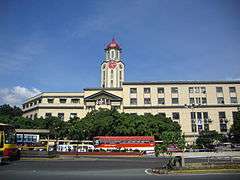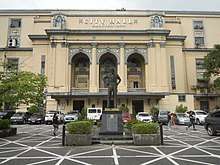Manila City Hall
| Manila City Hall | |
|---|---|
 The Manila City Hall as seen from Padre Burgos Avenue | |
| General information | |
| Status | Complete |
| Type | Government building |
| Location | Corners of Taft Avenue, Padre Burgos Avenue and Villegas Street, Ermita, Manila, Philippines |
| Coordinates | 14°35′23″N 120°58′54″E / 14.589793°N 120.981617°ECoordinates: 14°35′23″N 120°58′54″E / 14.589793°N 120.981617°E |
| Completed | August 19, 1941 |
| Opening | 1941 |
| Owner | City of Manila |
| Management | City of Manila |
| Design and construction | |
| Architect | Antonio M. Toledo |
| Developer | City of Manila |
| References | |
| [1] | |


The Manila City Hall (Filipino: Gusaling Panlungsod ng Maynila) is located in the historic center of Ermita, Manila. It is where the Mayor of Manila holds office and the chambers of the Manila City Council.[2] It was originally intended to be a part of a national government center envisioned by Daniel Burnham in the 1930s. Although the dream plan was not fully implemented, some buildings for the proposed government center was constructed, including the Old Legislative Building (now the National Museum of Fine Arts), and the Agriculture and Finance Buildings (presently the National Museum of Anthropology and National Museum of Natural History).
Architecture
The Manila City Hall during 1901 was made up of Oregon-pine which covered one third of the area used by the current building. After 31 years of occupancy, City Engineer Santiago Artiaga suggested to reinforce the floor of the weakened structure supporting the session hall used by the municipal board and avoid the accommodation of too many people along the corridors and in the hallway.[2] Eventually the old City Hall was then demolished
In the 1930s, a new 8,422 square meter-City Hall was constructed, which included around 200 rooms and uniform windows on all sides. This was designed by Antonio Toledo, the same architect who built the Finance and Old Legislative Buildings which were both adjacent to the new City Hall. Finished in 1941 right before World War II, it was another of the structural casualties of the War, heavily damaged (but still intact) by bombardment during the Battle and subsequent Liberation of Manila in February 1945. With the aid of the United States Army, Philippine Commonwealth Army and the city government, City Hall was reconstructed, though did not follow the original plans. Among the deviations were an added fifth-floor attic from the south entrance until the location of the east-west side entrances to accommodate additional offices,[2] and additional windows in some areas which were formerly shelling damages.
The building sits on a trapezoidal shape of the lot in between the Legislative and Post Office buildings. Due to the monotony of the building envelope, one cannot distinguish the principal facade from the main entrance properly. The south entrance has a balcony emphasized by three arches resting on Corinthian columns while the north rear has the same design treatment with the east and west sides, but has pediments all throughout and a tall, hexagonal clock tower capped by a dome.[3]
Successive administrations have left their mark on the building, which in recent years have further devaluated the building's pre- and immediate post-War beauty and glory. Among such marks include:
- all the trees inside and around the vicinity of the City Hall were planted by Manila Mayor Ramon Bagatsing during the early 1970s
- the clocktower's dome and clock faces were painted red (the hour markings and the hands picked out in white) sometime before the 1990s
- all of the office windows were eventually kept closed due to the noise, heat, and pollution, with some individual windows bearing the exhaust part of air conditioning units. Some of the windows were completely walled in, as well as the removal of the original pre-War window grills
- the north-side rear area was converted into a sort of fenced backyard, with a balcony constructed on top of the porte-cochère, obstructing the view of the large window
- the entire structure was painted in dirty yellow with details picked out in dirty gray by 2010
Clock Tower
The clock tower, also designed by Antonio Toledo which was completed during the 1930s is the largest clock tower in the Philippines, reaching close to 100 feet in elevation.[4] It stands out during nighttime when the whole of the tower lights up. Every hour, they rung the bell three times continued by a melody. It has now become the icon for the city of Manila.
The clock tower was first renovated during the time of Mayor Atienza. The second time was after Estrada won in 2013. He had the clocks upgraded and digitalized so that it will always be synchronized with the Philippine Atmospheric, Geophysical and Astronomical Services Administration (PAGASA) for Philippine Standard Time. He plans to convert it into a coffee shop and the first two floors of the tower had been turned into spacious halls.[5]
Architectural Reviews
During its heyday, the Manila City Hall was criticized because of monotony, lack of entrances and the clock tower location. But after years of its continued existence, the critics praise the design for its original intent. As other people may view it as a casket when seen from an aerial standpoint, it was intentionally formed to look like a shield of the Knights Templar which symbolized that the country is under the influence and protection of the Roman Catholic Church.
Due to its alleged casket-shaped building, it has also spawned tales of alleged paranormal activity in the building, none of which were visited nor confirmed by paranormal experts.
References
- ↑ "Historical Landmarks". City of Manila. Retrieved January 23, 2015.
- 1 2 3 de la Torre, Visitacion (1981). Landmarks of Manila: 1571-1930. Makati: Filipinas Foundation, Inc. pp. 19–20.
- ↑ Lico, Gerard (2008). Arkitekturang Filipino: A History of Architecture and Urbanism in the Philippines. Quezon City: The University of the Philippines Press. p. 291. ISBN 978-971-542-579-7.
- ↑ "Historical Landmarks: Manila City Hall". Manila..gov.ph. Retrieved June 2, 2014.
- ↑ See, Aie Balagtas (February 18, 2018). "Pinoy time may be acceptable to some but not at Manila City Hall tower". Philippine Daily Inquirer. Retrieved February 18, 2018.
External links
| Wikimedia Commons has media related to Manila City Hall. |
- Manila City Government – Official website

